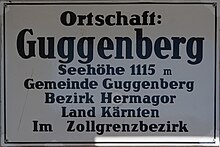Customs border district
The customs border district is the area in the vicinity of a customs border in which deviations from the law otherwise applicable in the customs area could arise through law or regulation .
Germany
Place-name signs
Beuthen O / S , around 1939
Oberammergau , 1960s
Wiechs am Randen , 2011
Kressbronn on Lake Constance , until 2013
Relic in Behrensdorf (Baltic Sea) , 2018
In Germany, this area is now referred to as a border area , Section 14 of the Customs Administration Act (ZollVG).
The customs border districts extend over an area of 30 kilometers from the customs border to the inland, this area can be expanded by the federal finance offices if necessary . According to Section 14 (1) sentence 1 ZollVG, the area near the border is 30 kilometers, from the seaward border of the customs area up to 50 kilometers. In this area, the officials of the Federal Customs Administration have powers that go well beyond those of the police , such as carrying out identity checks and searches of people and property that are independent of suspicion .
In addition, lower duty exemptions apply to people residing in the customs border district . The term "customs border district" still comes from the customs legislation of the prewar period and could be used instead of the administrative district on the signs since the introduction of the Road Traffic Regulations (StVO) that came into effect on January 1, 1938.
With the division of Germany, the two German states received their own legislation. In the west, the StVO remained valid from 1938 with reference to the customs border districts until 1971. Boards with this addition were also set up in West Germany after 1971. The West German Customs Act of June 14, 1961, which came into force on January 1, 1962, underpinned this regulation.
In the course of the Schengen Agreement and the European internal market , the term was abolished and replaced by the provisions of the Customs Code . The term has survived, but is slowly losing its meaning. The powers of the authorities in the border area now result from the police task laws of the federal states and the tax code . Since then, the Federal Customs Administration is no longer limited to the area of the immediate border within the scope of its controlling and monitoring tasks, but can operate throughout the federal territory (e.g. through mobile control groups on motorways). With the abolition of the regional tax offices and the establishment of five federal tax offices in 2008, the term mobile control group no longer exists. By merging several operational units of customs, these mobile control groups have been merged into the " traffic routes control units ".
Today the following communities and districts in Germany still refer to themselves as customs border districts: Bremerhaven , Emden , Grevesmühlen (district Grenzhausen), Hage , Norderney , Stühlingen (district Grimmelshofen ), Tengen (districts Wiechs am Randen and Uttenhofen ), Wertach , Wildenau (Selb) and Wilhelmshaven .
Austria

In Austria, the customs border district is an area on the edge of the national territory, which makes the movement of goods easier or more difficult than the customs inland , as the rest of the customs area is called. The customs border district is defined in the Customs Act 1955 §1. This strip of land must not be wider than 20 km and is determined by the Federal Ministry of Finance . The area is to be marked by the financial directorates' own boards.
As a result of this law, border residents, both at home and abroad, were allowed to import and export certain articles in larger quantities in accordance with the quantities they consumed themselves, which are specified in separate ordinances, in so-called local border traffic, duty-free. This mainly applies to tobacco products or alcoholic beverages, but also to medicinal products. The same applies to tools and machines that are re-imported as work aids on the same day. Pets and grazing animals are also allowed to cross the border in a simplified manner.
There are restrictions on structural matters that are close to the border, for example if they are used to monitor the border.
Traffic restrictions can also relate to the area of a customs border district if, for example, increased smuggling activity is detected. For example, it may be necessary to carry customs papers with you for the transport of some goods. Exceptions are rail or mail transports.
But the customs authorities also have special rights in this area, such as detention.
The law was republished in 1988, with individual changes being made in the meantime, but the overall content remaining roughly the same. For example, on the Danube, a customs border district was defined on the river kilometers in 1887 and 1933.
The locations in the customs border districts were determined, for example, in the Customs Act Implementing Ordinance 1992.
Web links
- BGBl. No. 874/1992 : Appendix 1 of the Customs Act Implementation Ordinance: List of the local communities belonging to the Austrian customs border district and parts of local communities according to Section 1, Paragraph 3 of the Customs Act (PDF; 1.78 MB)
Remarks
- ^ Ordinance on behavior in road traffic (Road Traffic Regulations - StVO -) of November 13, 1937 . In: Reichsgesetzblatt , Part 1, year 1937, No. 56, Berlin, November 16, 1937, p. 1193.
- ↑ Customs Act of June 14, 1961. In: Federal Law Gazette, Part 1, No. 42, Bonn, June 21, 1961, pp. 737–762.
- ↑ Federal Law Gazette No. 874/1992




